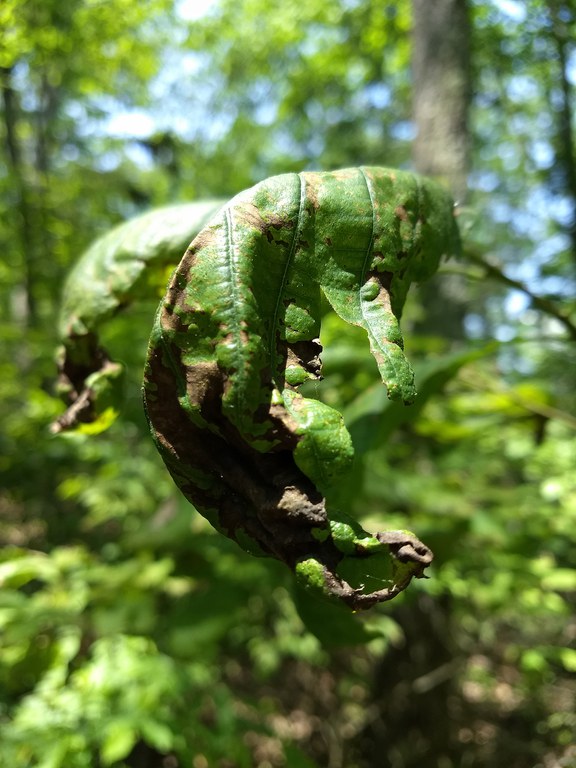Posted: June 4, 2018
Have you noticed more than a few oak trees losing leaves or showing brownish, papery, or necrotic foliage lately? You may be one of many central Pennsylvanians noticing an abundance of oak anthracnose, caused by the fungal pathogen Apiognomonia quercina.

The brown margins, and curling edges of this anthracnose infected chestnut oak are an early giveaway to the disease. Photo by Brent Harding, Penn State Department of Ecosystem Science and Management.
What is anthracnose?
Signs of anthracnose include brown and dead spots on leaves, curling or misshapen leaves, and loss of leaves ("defoliation"). If you look closely at the undersides of leaves near leaf veins or at twigs affected by anthracnose, you may find small, pimple-like fungal structures. Try using a magnifying glass or hand lens to see these structures more clearly.
When you observe brown and curled leaves on a tree that appeared healthy last summer, you might understandably suspect the dramatic appearance of some new disease in the woods. Anthracnose, however, was likely already present in the landscape on plant tissues affected last year. In spring, wind and splashing rainwater spread anthracnose spores that infect twigs, emerging buds, and new leaves. This is one of the reasons experts advise against pruning, a practice that introduces more potential infection sites, during springtime or in wet weather.
The observed severity of oak anthracnose has everything to do with weather; prolonged wet conditions early in the growing season spell out a worst-case scenario. While we usually observe only mild damage to oak leaves from anthracnose, this year's notably wet spring created optimal conditions for this fungal pathogen to thrive, and, as those with affected oaks can attest, damage this season tends to be more severe.
How do I know if my tree is affected?
First, look for those tell-tale signs: brown or misshapen leaves, early-season defoliation, and pimple-like fungal structures. Not all oaks are equally susceptible, though. White oak and other oak species in the white oak group tend to be more sensitive to anthracnose. One of the simplest rules of thumb you can use to identify trees belonging the white oak group relates to the rounded lobes on their leaves; species in the red oak group, on the other hand, tend to have bristled or pointed lobes. This season, reports of anthracnose have been on white oak and chestnut oak in particular.
Despite this year's prevalence of anthracnose, it doesn't hurt to rule out other possible diseases that could be affecting your oak trees. Oak wilt involves dramatic leaf damage in a short amount of time, particularly affects species in the red oak group, and requires more aggressive management approaches to prevent further damage. A few other common oak diseases are detailed in Penn State Extension's Oak Diseases factsheet.
For conclusive identification of a disease, you can submit a plant tissue specimen to Penn State's Plant Disease Clinic, where the sample will be tested and diagnosed. There is no charge for this service. Submission instructions can be found online or through your local Penn State Extension Office.
What do I do if my trees show signs of oak anthracnose?
If your problem really is anthracnose, don't panic! Oaks defoliated by anthracnose are capable of growing new leaves later in the season, a process called "refoliation." Wait and see how your oaks recover. Using energy to recover from any defoliation event is stressful to an oak tree, but one defoliation in a season is not likely to kill or seriously harm the tree.
Repeated defoliations, or additional stress events for the same tree in the same season or in successive years, can be more serious. A major anthracnose-related defoliation followed by something like drought or heavy gypsy moth pressure may stress a tree enough to cause a decline in health. Think of it this way: in a few months, you can catch the flu, fight it, and feel better, but it's much more difficult to handle the flu, a broken leg, and a hastening deadline at work in those same few months. Be on the lookout for these compounding stressors later in the growing season, when you might be able to give a leg up to a few high-value yard trees through fertilization or watering, but for now, just keep an eye on your oaks and cheer on their recovery.
If only a few yard trees are affected, consider raking and removing anthracnose-laden leaves to reduce future infection risk, but if your affected trees are in a woodlot, leave the litter layer on the forest floor intact. Some pruning may also be advisable in the fall or during the dormant season, but be sure to adhere to your municipality's pruning ordinances. For now, though, a patient, "wait-and-see" approach is probably your best bet.
Resources:
Anthracnose on shade trees
Oak Diseases Factsheet
Plant Disease Clinic
James C. Finley Center for Private Forests
Address
416 Forest Resources BuildingUniversity Park, PA 16802
- Email PrivateForests@psu.edu
- Office 814-863-0401
- Fax 814-865-6275
James C. Finley Center for Private Forests
Address
416 Forest Resources BuildingUniversity Park, PA 16802
- Email PrivateForests@psu.edu
- Office 814-863-0401
- Fax 814-865-6275

